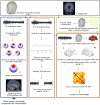Source connectivity patterns in the default mode network differ between elderly golf-novices and non-golfers
- PMID: 37069191
- PMCID: PMC10110620
- DOI: 10.1038/s41598-023-31893-1
Source connectivity patterns in the default mode network differ between elderly golf-novices and non-golfers
Erratum in
-
Publisher Correction: Source connectivity patterns in the default mode network differ between elderly golf-novices and non-golfers.Sci Rep. 2023 May 5;13(1):7336. doi: 10.1038/s41598-023-34581-2. Sci Rep. 2023. PMID: 37147341 Free PMC article. No abstract available.
Abstract
Learning to play golf has high demands on attention and therefore may counteract age-related changes of functional brain networks. This cross-sectional study compared source connectivity in the Default Mode Network (DMN) between elderly golf novices and non-golfers. Four-minute resting-state electroencephalography (128 channels) from 22 elderly people (mean age 67 ± 4.3 years, 55% females) were recorded after completing a 22-week golf learning program or after having continued with normal life. Source connectivity was assessed after co-registration of EEG data with native MRI within pre-defined portions of the DMN in the beta band (14-25 Hz). Non-golfers had significantly higher source connectivity values in the anterior DMN compared to non-golfers. Exploratory correlation analyses did not indicate an association to cognitive performance in either group. Inverse correlations between a marker of external attention with source connectivity of the anterior DMN may suggest a trend in the golf group only, but have to be replicated in future studies. Clinical relevance of these findings remains to be elucidated, but the observed difference in the anterior DMN may provide a starting point to further investigate if and how learning golf may have an impact on physiological age-related cognitive changes.
© 2023. The Author(s).
Conflict of interest statement
The golf training was financially supported by the Heinz Nixdorf Westfalian foundation. The authors declare no other conflicts of interest.
Figures



Similar articles
-
Default Mode Network and Neural Phase Synchronization in Healthy Aging: A Resting State EEG Study.Neuroscience. 2022 Mar 1;485:116-128. doi: 10.1016/j.neuroscience.2022.01.008. Epub 2022 Jan 17. Neuroscience. 2022. PMID: 35051530
-
A Longitudinal Study of Changes in Resting-State Functional Magnetic Resonance Imaging Functional Connectivity Networks During Healthy Aging.Brain Connect. 2020 Sep;10(7):377-384. doi: 10.1089/brain.2019.0724. Epub 2020 Aug 19. Brain Connect. 2020. PMID: 32623915 Free PMC article.
-
Disrupted functional connectivity of default mode and salience networks in chronic pancreatitis patients.Clin Neurophysiol. 2020 May;131(5):1021-1029. doi: 10.1016/j.clinph.2020.01.016. Epub 2020 Feb 10. Clin Neurophysiol. 2020. PMID: 32197125
-
Enhanced resting-state EEG source functional connectivity within the default mode and reward-salience networks in internet gaming disorder.Psychol Med. 2022 Aug;52(11):2189-2197. doi: 10.1017/S0033291722000137. Epub 2022 Feb 23. Psychol Med. 2022. PMID: 35193713 Free PMC article.
-
Electroencephalography Source Functional Connectivity Reveals Abnormal High-Frequency Communication Among Large-Scale Functional Networks in Depression.Biol Psychiatry Cogn Neurosci Neuroimaging. 2018 Jan;3(1):50-58. doi: 10.1016/j.bpsc.2017.07.001. Epub 2017 Jul 13. Biol Psychiatry Cogn Neurosci Neuroimaging. 2018. PMID: 29397079 Free PMC article.
References
Publication types
MeSH terms
LinkOut - more resources
Full Text Sources

